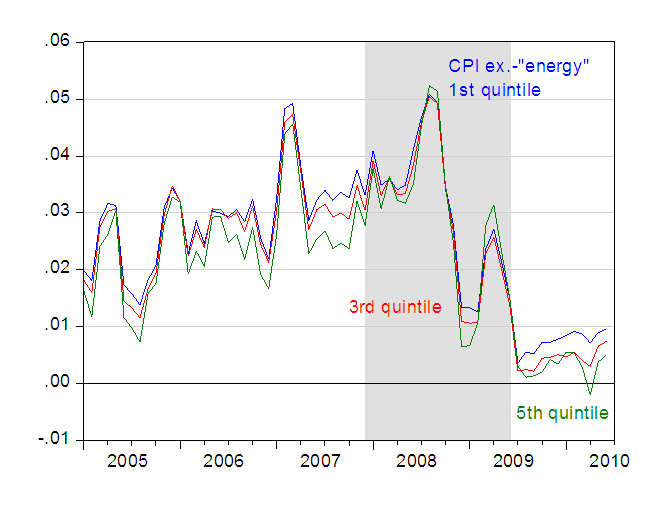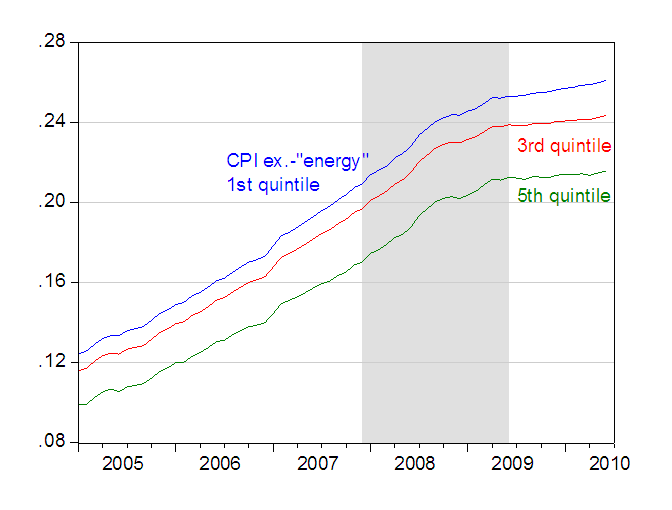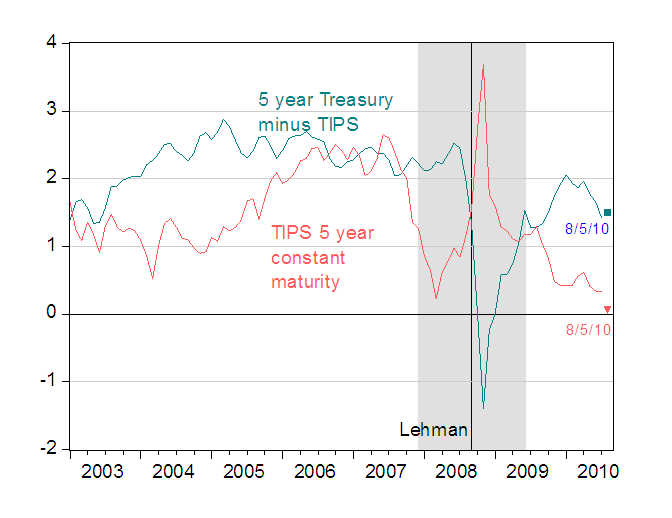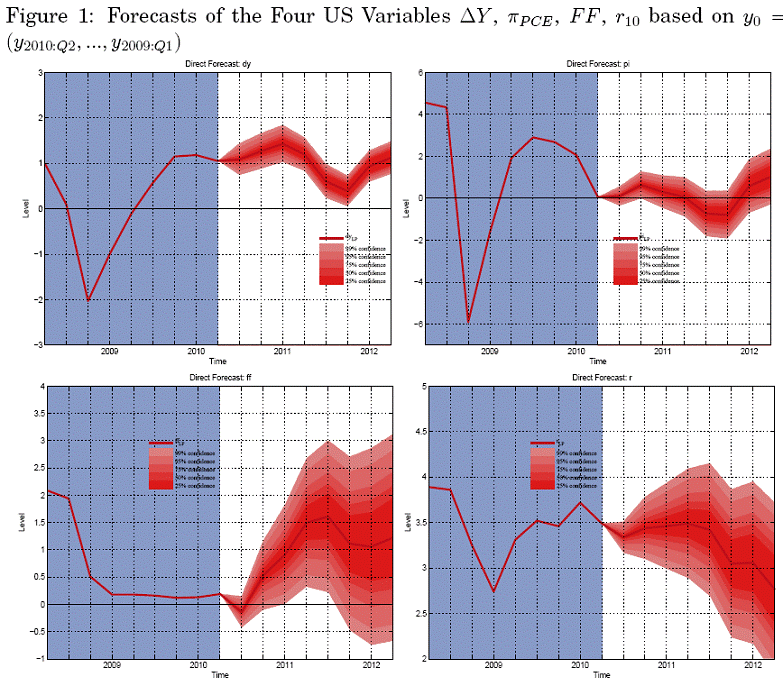It’s a schizophrenic world. On one side, there are lots of people worried about hyperinflation [0], despite forward looking indicators of inflation signalling quiescence [1] and actual price indicators going downward.
On the other are those who actually look at the data, and then conjoin their observations with information on the tremendous slack in the economy, and say that rapid inflation is unlikely. So while all eyes are on this Friday’s CPI release, I assert that we don’t really have to wait to find out the trajectory of inflation. In this post, I will highlight the fact that over certain horizons, we already have deflation; and for certain segments of the population, inflation has been at zero for a year already.
Core Inflation
First, consider standard indicators. The core CPI and core PCE deflator inflation rates are still positive.

Figure 1: Core CPI (blue) 3 month annualized inflation, and core personal consumption expenditure deflator (red) 3 month annualized inflation. Gray shaded area denotes recession, assuming trough at 2009M06. Source: BLS and BEA via FRED II, and NBER, and author’s calculations.
For discussion of differences in coverage, weights, and construction between CPI and PCE, see this post. From these conventional indicators, it would seem we are still aways from deflation.
Measures of Inflation, by Income Group
It is important to keep in mind that the impact of price changes on the cost of living differs across income groups, as I discussed in this post. Figure 2 depicts the 3 month annualized growth rate in the CPI as it pertains to the 1st, 3rd, and 5th income quintiles.

Figure 2: Three month annualized inflation calculated using guesstimated CPI ex.-energy for first quintile (blue), third quintile (red), and fifth quintile (green). Guesstimated CPIs calculated as arithmetic averages of component indices; excludes “private transportation” and “fuel and utilities” from the housing component. Source: BLS, and author’s calculations based on weights in Kokoski (2003), Table 5.
A caveat: I call these guesstimates because I am not always certain that the categories I have selected match up with the series Kokoski uses in her calculations. In addition, I do not believe that my ex.-“energy” series matches up with the construction of the official CPI excluding energy and fuel series reported by the BLS. I welcome cross-checking. However, I think the deviations of the movements by quintile should be representative.
Clearly, (3 month annualized) inflation for the 5th quintile is very close to stall speed, at about half a percentage point in June 2010. In contrast, inflation being experienced by the 1st income quintile is nearly 1 percentage point. Another way to highlight this difference is to examine the (log) levels of the indices.

Figure 3: Log guesstimated CPI nerg ex.-“energy” for first quintile (blue), third quintile (red), and fifth quintile (green) (2000=0). Guesstimated CPIs calculated as arithmetic averages of component indices; excludes “private transportation” and “fuel and utilities” from the housing component. Source: BLS, and author’s calculations based on weights in Kokoski (2003), Table 5.
Notice that the 5th quintile CPI ex.-“energy” is essentially flat since 2009M07. Running a regression on first differences (remember log price indices are at the very minimum I(1), and arguably I(2) over some samples), one finds that the implied annualized inflation rate is 0.3 percentage points, and is not statistically significantly different from zero at the 10% msl. In contrast, the core CPI inflation rate over the corresponding period is 1 percentage point, and is significantly different from zero, with a p-value of 0.015 (both regressions using HAC standard errors, 2 lags).
Why should one care about the 5th quintile? If one is concerned about aggregate consumption, then it is of interest to know what happens to the top 20%. According to Moody’s, about 60 percent of total consumption is accounted for by this quintile [2]. If the price level facing this group is falling, then they might either defer consumption in anticipation of yet lower prices, or either increase or decrease consumption in response to changes in wealth (depending on whether they are net creditors or debtors). (The overall CPI weights, according to Deaton, corresponds to about the 75th percentile in income.)
Additional Observations
The CPI-all inflation rates (3 month annualized) for the 3rd and 5th quintiles have been negative since May and April respectively. Even that for the 1st quintile has declined as of June. This matches up with the declining inflation for the standard CPI-all, since May.
We know that the CPI is upwardly biased, due to the use of fixed weights for the major categories. That means that if one could apply a Fisher ideal index to these data, for each quintile, one would probably obtain more negative inflation rates. [3]
Parting Thought
We have forward looking market-based indicators of expected inflation. One is the spread between the 5 year Treasury rate and the corresponding 5 year TIPS. Keeping in mind the problems with using the spread to infer inflation [4], here is the picture.

Figure 4: Difference between five year and five year TIPS constant maturity yields (teal), and five year TIPS constant maturity yields, monthly averages of daily data. Observations for August denote data for August 5, 2010. NBER defined recession dates shaded gray. Source: FREDII and NBER, and author calculations.
With these points in mind, and with tremendous slack in the economy, rapid inflation seems like the last thing one should worry about. Or crowding out, for that matter [5].
Update: 11:30am Pacific, 8/10/2010
Oscar Jorda has just sent me a note written by a UC Davis PhD student, Paul Gaggl, which reports the unconditional forecasts and associated fan charts for a simple four variable VAR (GDP growth, PCE inflation, Fed funds rate, ten year bond rate). Pay close attention to the top rightmost graph in the chart.

Figure 1 from Gaggl (2010).
I’m not saying this particular VAR is the definitive word in how to model inflation, but I think it indicates the fact that based upon historical correlations, there is ample evidence to support the view that deflation is very possible. (The referenced Jorda/Marcellino paper is here)
In other news, WSJ RTE/Izzo reports:
A Wall Street Journal survey found that by a two-to-one margin Wall Street economists see deflation as a bigger threat to the U.S. economy over the next three years than inflation.
“Deflation is dangerously close,” said David Resler of Nomura Securities, one of 53 economists surveyed by the Wall Street Journal. Among economists who answered the question, nearly two-thirds said that deflation poses the bigger risk to the economy over the next three years; the remainder said inflation is the bigger threat. That compares to an April survey, when the economists were split 50/50 over whether inflation or disinflation posed the bigger risk over the next year.
5-year inflation swaps paint a similar picture and are (presumably) a more direct market-based measure of inflation expectations.
Disinflation or deflation alongside a zero bound makes things even worse. Ordinarily it is positive interest rates that are responsible for a downward sloping aggregate demand curve. But if interest rates are at a zero lower bound, then the slope of the aggregate demand curve is determined by the relative effects of lower prices giving us more buying power (a Pigou effect) versus the effect of deflation on debtors. With deflation debtors will cut back on consumption. Yes, owners of debt will have more income from debt payments of debtors, but more of that debt income will be saved. I think that’s what the quintile charts show. Low income quintiles don’t have a lot of options. The net effect is that the this debt effect overwhelms the real balance effect, and this implies that the aggregate demand curve will be (locally) upward sloping. And that means deflation not only leads to more deflation, but a rightward shift in the aggregate supply curve actually reduces output. A world turned upside down. We better hope this is nothing more than a theoretical musing.
Perhaps the current deflationary depression is a unique opportunity to monetize the debt without causing proportional inflation.
On the other hand, we’re so far into uncharted territory, they’ll probably blow something up when they try it.
Menzie: For the question at hand, another source to consider:
http://www.clevelandfed.org/research/data/inflation_expectations/index.cfm
Broad commodity indexes are up about 20% in the last 18 months. Equities up over 30%. TIPS and Treasuries are also up. In the wonderland of ZIRP, it’s all good. Are all those markets predicting low inflation?
Does the Treasury bond market reflect a sober calculation of the risks ahead or does it reflect a toxic cocktail of central bank manipulation (both foreign and US)along with leveraged speculators? Time will tell.
Nemo: Thanks for the useful link.
Phil Rothman: Thanks! I have a plot from a month ago using this data here.
2slugbaits: Good observations. If anybody knows whether the top quintile is net debtor on paper assets (as opposed to real assets), please send along the info.
tinbox: I’ll just note that survey based expectations (such as the one mentioned by Phil Rothman) are also trending down.
“Broad commodity indexes are up about 20% in the last 18 months. Equities up over 30%”
Please, that is hardly impressive considering the losses that were obtained previously. If Big Capital doesn’t start spending again, than “broad” base commodity indexes and the stock markets will all “correct” again and lose half of those ‘gains’.
The ability to draw any inflation is if Big Capital starts spending again to give the American idiots…..err I mean people confidence to start spending again with the savings they have collected(this, they wouldn’t have if a direct liquidation had taken place). Then the economy will pick up slack and job growth will resume.
That is the way the system is run. Big Capital always is the starter on the car.
While the Treasuries minus TIPS estimate of inflation is theoretically ok, though I’ve never seen anyone actually use TIPS that way and the tax ramifications make the equation highly inexact, my point is that there are other markets that are hard to reconcile with the low inflation sentiment.
It is pretty clear that the housing element will keep overall inflation measures in check for many, many months. And the dismal employment situation will also have a significant downward impact on pricing. These aspects of the economy are well known and not really disputed.
But if the main function of the Fed over the next few years is to ensure that domestic housing prices (the weakest asset sector by far) do not fall significantly further, then what should reasonable, non-hyperinflationistas, expect prices for other goods and services to do?
Menzie:
See more on inflation expectations here.
The Rage:
I’ll agree with tinman. Industrial commodoties are still far off their highs because we are in a huge bust coming off of a huge bubble. Gold, however, has relatively little industrial use and is more of a pure play on paper currency debasement. It’s hitting new highs this year.
If we stay in a depression forever, it may be possible to borrow and print obscene amounts of money without causing inflation. But anyone who thinks Congress and the Fed will be able to instantly unwind everything they’re doing once a recovery or inflation takes hold is smoking something.
Commodities are an essential part of any long-term portfolio, and they’re on sale right now. The GSG ETF is one easy way to do it.
Perhaps we can fix the depression by allowing everyone to go to work for the government .
Menzie: I haven’t heard you trumpeting the ARRA as our miracle solution lately???? FAIL!
Good post.
So, what the heck is the Fed doing, exactly?
Based on the performance of the Fed over the last, say, decade or so, does anyone have any confidence whatsoever in this failed institution?
I’ve never been a Ron Pauler, but could “free banking” be any worse whan what we have now.
To be fair to those seeing hyperinflation in our future, they’re reacting to fiscal policy more than monetary policy. And by any measure, in GOLD terms there has been tremendous inflation over the past 5 years or so.
If only Bernanke could listen to Bernanke and follow the suggestions laid out by Bernanke a decade or so ago. Bernanke could do all kinds of unconventional things to reflate the economy if only he’d listen to Bernanke!
Inflation is here. Remember inflation is the expansion of the money supply and PPI shows this. Where’s the M3 figures?
Don’t worry we’ll all just defend Bernanke and his Back door bailouts.
The liqudity preference curve is a false doctrine, viz, Alfred Marshall’s “money paradox”.
Consumers have been tapping their savings (now their largely tapped out). In the process, bank customers have been shifting their balances from interest bearing savings accounts into primarily -demand deposits. This represents, for the most part, a one-time transaction, from non-m1, into m1 deposit classifications.
The Great Recessions dis-savings is analogous to the “time bomb” that took place in the 1st qtr of 1981 (with the widespread introduction of ATS, NOW, & MMMF accounts). It is a velocity relationship.
After people have initially dipped into their accumulated savings, and after a time lag, the effect of this liquidation and their spending behavior, eventually has to die out.
Because of the magnitude of the previous dis-savings (and nothing to replace it), and for this reason standing alone, we can expect another downswing.
I.e., this “dis-savings” proportionately, is akin to monster QE stimulus – that is now expiring. That is from a monetarist point of view, aggregate monetary demand is completely collapsing
Andrew: That’s your definition of inflation. That’s not the way I teach it (and is defined in the macro textbooks). I looked at PPI-all commodiites inflation; that’s negative year-on-year; Core PPI inflation is slightly above 0.5 ppts, year-on-year. Both are on the St. Louis Fed’s FREDII site.
okay Menzie,
Please explain why the huge govt deficit is not causing inflation and higher interest rates like many so called expert economist predicted. Or do the MMT crowd (Warren Mosler and Bill Mitchell – to name two) have it right?
No fair-minded person would expect macro-minded academic economists to be any better at forecasting future inflation rates than they are at forecasting any other economic variable. That is, no better or worse than using naive projections or asking the man in the street.
However, no forecasting ability is needed to recognise that nothing – but nothing – at this point would be more helpful to the political establishment in many countries than a burst of inflation that spilled over into housing, job creation and wages.
And, faster than you could say G. William Miller, the rate would accelerate.
That is what worries the thoughtful.
It is a scientific fact that economic forecasts are mathematically infallible. This derives from the fact that monetary flows are always of fixed duration (based on the last 97 years of statistics).
I.e., money is the measure of liquidity, the yardstick by which all other assets are measured. The transactions velocity represents money actually exchanging hands, ergo, bank debits (the G.6 metric).
I.e., aggregate monetary demand (nominal gdp), is our means-of-payment money X its transactions rate of turnover (not income velocity).
Historical cost pressures, and the complaints of private institutions, have forced the elimination & consolidation of many of our reported statistical releases. Using degraded measures has handicapped the economics profession, to the detriment of economic forecasts, and our fragile economy.
Forecasters continue to innovate, testing and re-testing every conceivable mathematical variable. Unfortunately, it has been a losing battle.
“I’ve never been a Ron Pauler, but could “free banking” be any worse whan what we have now.”
Pure scam by the bankers not in power. Everything the “market” decides is created and rigged by cabalist looking for profit. Of course you will have “intellectuals” that say it was a big success in the past, but it truth, they “failed” each time and become dictorial to a country, which is why they were dropped each time. Free banking is not free. When Jefferson made his remarks about private banking as first creating inflation than deflation to rob a nation of its wealth, stuff like the “gold standard” and “free banking” is what he was slamming. People don’t get that, istead, anti-americans like Ron Paul try to use for their globalist schemes. Ron Paul and Che Guevara are 2 examples of why I can’t stand Doctors in politics.
Buzz, a better bet is to find which bankers are “out of the loop” in the current system and then tie their capital flows to Ron Paul and other “free market intellectuals” of the ilk. The man is not a rebel but part of the cabal. Just a different side.
Sorry, but I just don’t see the problem of inflation other than creditors losing out. Listen, the creditors were as much in fault as the debtors and should have to bear some of the write downs. Having the government push that inflation through investment was how America kept the economy growing and consistantly changing itself for decades after the 30’s. But now, the government has completely given up that responsibility to Big Capital and the “private” “central” banks of today, instead of using public institutions and manipulating the “private” central banks to their own accord(oh, but this was so awfull).
I don’t buy Americans are tapped out either. Put it this way, the cost of the bank bailout has been considerably less than the cost of the collapse as peoples money would have been completely “deflated away” and gone as probably 100% of banks would have failed in America(and globally). That is savings completely wiped out. The same savings that the plutocracy laughed at being wiped out during the great contraction of 29-33. You can see the savings destroyed.
It is little surprise the savings rate has lifted up and people are not hoarding cash. Considering the lack of investment into their lively hood, I can’t blame them, but tapped out? Please, the creditors are tapped out and pathetic. It made the plutocracies bailout so revolting but necessary to prevent depression(sorry, but I don’t see depression)
If you want no bailouts and robust economy, you need some restructuring of wealth and investment. Big Capital won’t go down without a fight.
Andrew: Sorry, but that’s not even close to any plausible definition of inflation. Inflation represents the rate of change of some price level. Inflation captures price inertia, which is why we generally look at core rates of inflation rather than indices that include volatile commodities. Now it is true that the quantity theory of money says that doubling the money supply doubles the price level…well, not quite. What the quantity theory of money actually says is permanently doubling the money supply doubles the price level. If the Fed announced that tomorrow they would double the money supply but on Thursday they would cut it in half, my guess is that not too many folks would expect prices to double on Wednesday and fall by half on Thursday even if Calvo menu costs were zero. The other thing to keep in mind is the definition of money. The Fed directly controls base money, but businesses and consumers control money velocity. So any definition of money (M1, M2, MZM, take your pick) is only partially controlled by the Fed. In fact, back in the heyday of Milton Friedman (like the early Volcker years) the Fed failed miserably at trying to control the money supply.
America is experiencing a novel situation. The asset most utilized for collateral: real estate, continues its long decline – destroying liquidity, credit, money, and markets in its wake. Balancing this is expanding demand in the emerging economies. There, higher wages, increased industrial demand , and a burgeoning consumer market will result in higher imported finished good and commodity prices in America.
It should come as no surprise that the plutocrats of the 5th quintile experience flat prices as demand for their luxury goods evaporates with the market for McMansions. The troglodytes of the first quartile experience the fun of competing with the Asian masses for food, fuel, and cheap Wal-Mart consumables.
As has been repeated many times by JDH, the outlook in America is short-term deflation (as domestic markets contract), but longer-term inflation (as market expansion overseas causes the demand necessary for overall price levels to rise).
The Fed’s announcement today is another indication that they’re going to keep pushing on a string as long and as hard as it takes.
They may be able to create asset bubbles and commodity inflation, but they’re not going to create jobs or wage inflation.
The Fed’s announcement today is another indication that they’re going to keep pushing on a string as long and as hard as it takes.
They may be able to create asset bubbles and commodity inflation, but they’re not going to create jobs or wage inflation.